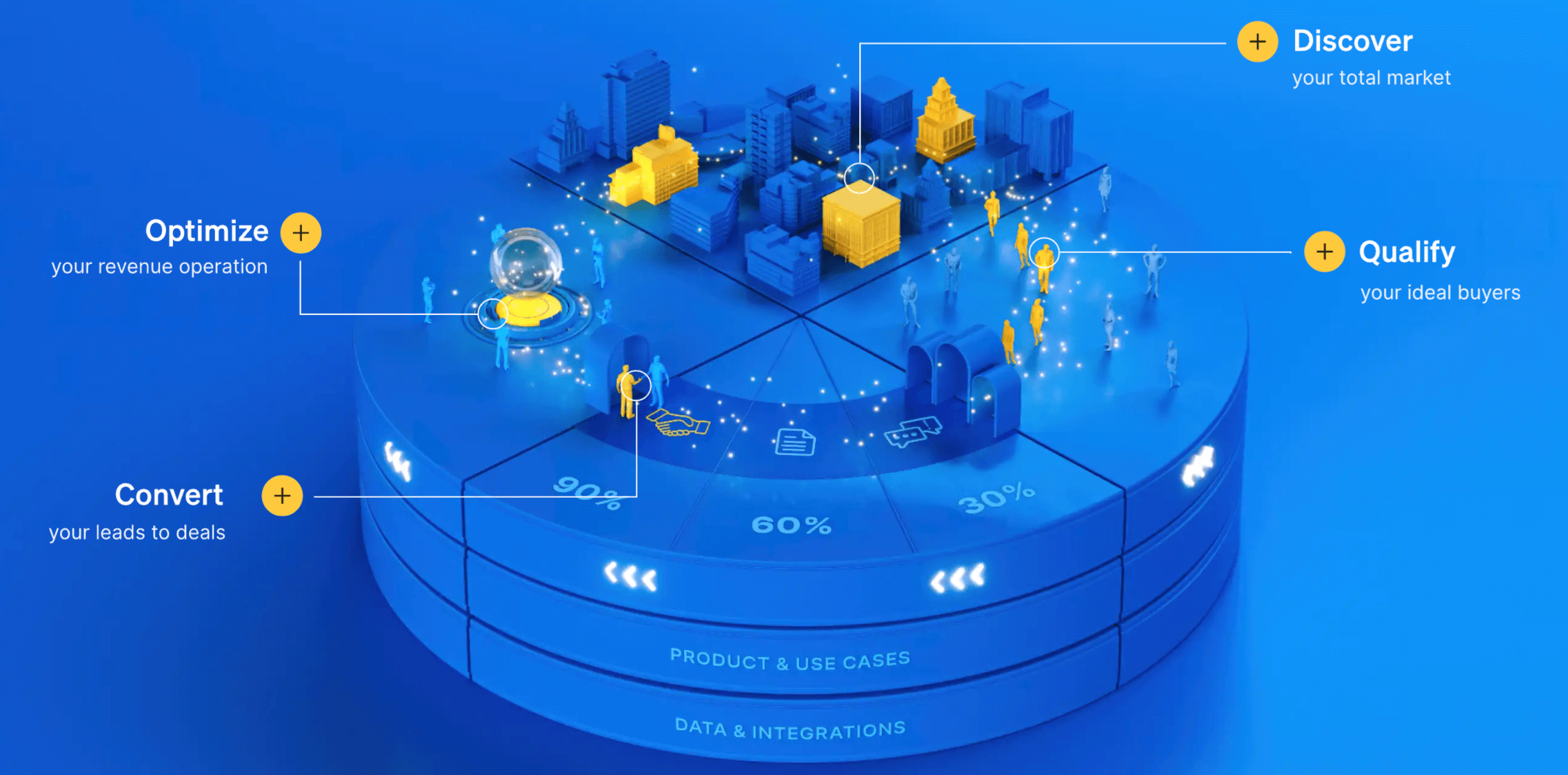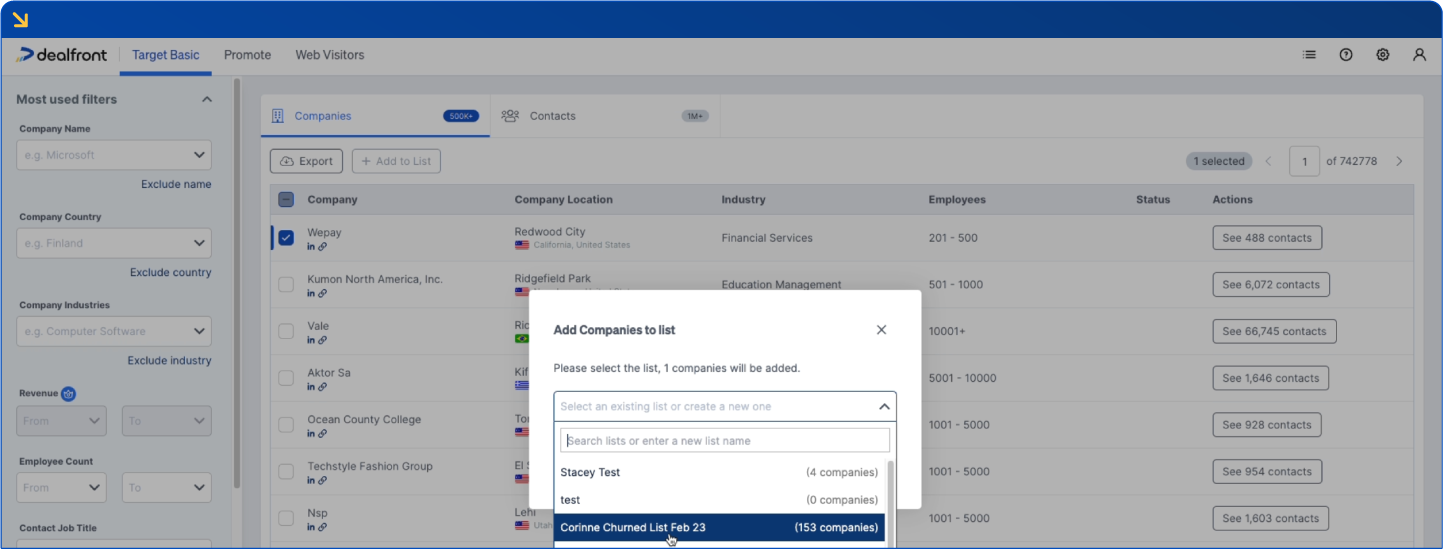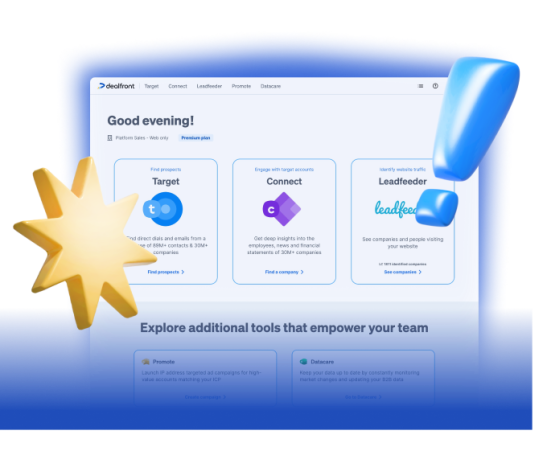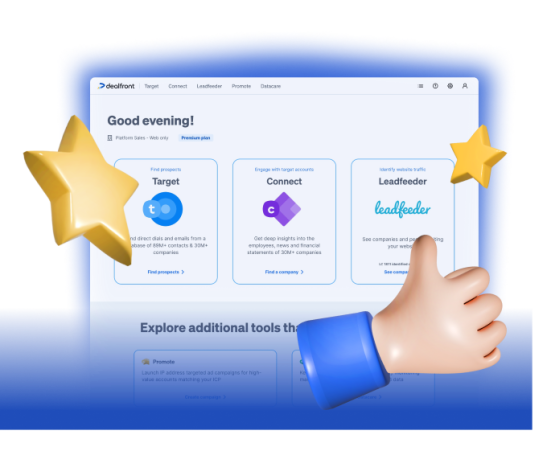Picture this: you want to launch a company, product or service. Of course, a robust go-to-market strategy is an absolutely vital part of this journey. But what if you could boost your chances of success by adding a solution that takes all the guesswork out of the equation? Enter Dealfront, the go-to-market platform for Europe.
That all sounds great, right? But what exactly does the platform truly offer, and is it really a solution that does what it says on the box? Glad you asked because we’re going to be sharing with you exactly how our platform helps you win the European market. We’ll also be letting you take a peek behind the scenes and show you how Dealfront uses Dealfront.
What is Dealfront?
As the joint merger of Germany’s Echobot and Finland’s Leadfeeder, Dealfront’s platform is built on live European data, and it understands the nuances in European languages, culture, and regulations.
The platform can access data and insights that other tools can’t while offering transparency and complying with Europe’s strict and complex regulations.
Dealfront combines the tools and stages of the sales and marketing process into a single platform, powering a flywheel that optimizes the entire operation in a perpetual loop. The result is constantly refined accuracy, ICPs that are dynamic and real-time, and more leads that end in deals.
But just how can the platform work for you?
Dealfront is a full-service go-to-market platform that equips sales and marketing teams with the tools they need to succeed in any European market. Using the platform, companies can identify and land ideal customers quickly and efficiently, ultimately increasing their bottom line and establishing a revenue engine.
Companies can discover more opportunities, qualify leads, convert them into customers, and optimize their team's performance. With Dealfront, businesses can bring their flywheel to life and watch sales happen in real-time.

What sets us apart from the competition:
The Dealfront data is drawn from four layers of data—company databases, web crawling, web visitor analysis, and sales triggers. The deep data provides a deep understanding of how to reach your revenue potential.
With German and Finnish origins, Dealfront has a native understanding of the European market. Trained on European data and with teams supporting clients in many local languages, it provides data and insights that others can’t.
Data is useless unless paired with an integrated platform of powerful applications. This is why we believe a strong combination of data and integrated and collaborative applications will outperform competitive point solutions.
Dealfront meets the highest GDPR compliance and privacy standards and shows users how the data was sourced. The platform is hosted in Europe and processed under European regulation—user data is secure and won't be sold to third parties.
In short, our platform doesn’t just give you pieces of the go-to-market puzzle for you to solve on your own, we give you the whole picture.
Let’s breakdown each product within the platform:
The Dealfront suite of products
Target
Target is a B2B sales prospecting tool that helps customers create company and lead lists and find contact details of key decision-makers. Target offers unique filtering options that go far beyond the standard of just company address, location, and number of employees.
With Target, companies in any industry can boost their prospecting, market analysis, and B2B lead generation. Thanks to Target, our customers ensure they are exclusively targeting companies that fit their Ideal Customer Profile (ICP).
Leadfeeder
Leadfeeder helps businesses understand and engage with their website visitors in real time. With Leadfeeder, you can track visitor behavior, gain insights into their interests, and use that data to set your sales team up for effective prospecting.
Connect
Connect supports companies by properly prioritizing their target companies and giving insights on when to reach out to the most relevant companies at the right time. With B2B data on over 30 million companies from trade registries, company websites, news, and social media, our clients receive in-depth company information. Also, Connect provides 360° company profiles that help accurately assess companies, customize pitches, and stay one step ahead of competitors.
Datacare
Datacare helps companies review, cleanse, enrich, and optimize their data records (mostly inside their preferred CRM systems). Thanks to a variety of intelligent features such as data enrichment, reachability checking, the detection of company forms (LLC, Inc., etc.), and address changes, Datacare ensures that companies can maintain and improve the quality of their B2B data at all times.
Promote
Promote is a B2B display advertising solution that helps businesses reach their ideal customers by targeting specific companies with programmatic display ads. By defining their target audience and setting up campaigns, businesses can use brand and product awareness campaigns targeted to their most important account lists.
So what does this all look like in practice? We chatted with some of our internal experts who shared how they use the Dealfront platform.
How Dealfront uses Dealfront
The best way to explain our solution is to show you. We asked around and as you can imagine, there are a few use cases that will seem familiar to you if you’re in a sales or marketing team. But our platform has a few tricks up its sleeve.
How the sales team uses Dealfront
Outbound
Stuart Moss - Director of Sales Development
We use Target to find companies and contacts within our focus areas to target across the whole SDR organization.
I wanted to focus on driving outbound efficiency within my team, so we stopped giving them a list of accounts. We can use our platform to filter accounts by things like company size or industry.

Also, we can go even further by finding the right types of people within those accounts. So instead of some kind of random list, we have a highly-filtered list of people we want to specifically target because they meet our criteria.
I’ve used the following filters:
Company size: If you want to target smaller, SME or enterprise
Industry: The sector your target company is in
Job title search: The title your contact person should have
Trigger events: I used “Revenue increase in the last 3 months”
Countries & Regions: Where your target companies are located
Contact profile completeness: I want to reach out via LinkedIn so I selected only those contacts that have a LinkedIn profile.

So now, I’m left with a selection of just 22 companies and 74 contacts instead of potentially thousands of companies before I used the filters.
What does this actually mean? We cut down the manual research time so my team can focus on the outreach. I want my team to have the time to talk to people. And, any time won is also put into tailoring the outreach so contacts have a more personalized experience. You could have volume, but why have volume when you can have quality which ultimately increases your conversion rate?
Inbound
Alicia Murphy - Team Lead, PLG Sales USA
On my team, we use Leadfeeder to monitor a company’s behavior while on our website. The way we do this is, we create custom feeds with CRM attributes like “deal is open” or “deal is lost” for each team member. We can then assign behaviors such as “viewed pricing page” to them.

We have a Slack channel called “deals on the pricing page” where we’ve set up an automation.

Each team member gets a Slack alert in that channel when one of their deals engages in “viewed pricing page” or in another attribute they’ve designated.

This way, we can use the information that the visitor is interested in the pricing to reach out again when the time is right!
How the marketing team uses Dealfront
Content marketing
Franziska Hoer - Content Creator
My main use case with our platform is to track which companies are downloading our ungated content.

Every marketer would like to ungate their content and ungated content is becoming more popular for several reasons:
It creates demand.
Gated content creates a barrier because readers feel that they have to give something to get something.
Users will feel comfortable about interacting with your brand.
But marketers fear they will lose the precious data on who is doing the downloading.
Spoiler alert: You don't have to gate content to generate leads.
Leadfeeder solves this by allowing me to still track companies that download our content. Even better, you can track the actions they take on your site before and after they download content. For example, you might see that users who download a specific guide are more likely to request a demo, which tells you that the content is doing its job! Great insights without the fear of not getting value.
Additionally, you can see if the right companies are downloading your content.
Growth marketing
Dáire Summerville - Director of Growth & Product Marketing
Monitoring Google Ads traffic is my main use case and to do this I use Leadfeeder to set up a custom feed just for that.

I can see which companies are coming in from a specific campaign and assess if they’re the companies we actually want to target. Are they of high quality or not?
I also get activity updates daily or weekly sent to my email so I never miss out. When a target company that is flagged is active on your website you can then take a look at how they’ve been behaving.
How the revenue team uses Dealfront
Growth and RevOps
Joe Henson - PLG Sales, Senior Account Executive
I use Leadfeeder for lost deal tracking. I set up a custom feed to get notifications when a lost deal revisits our website and more specifically, which pages are visited. This is great because when we can see if they’re visiting our product pages, we can target our outreach to reflect that. For example, they were looking at Connect and we can say “Hey, I noticed you were interested in learning more about Connect. How can I help you understand/learn more about it?”
In terms of Target, I use this as my standard contact directory/database. It helps me find new contacts to reach out to and cuts down research time (which we all love).
Customer Success
Corinne Kinnicutt - Customer Success
In my role, my main tools are Leadfeeder and Target. With Leadfeeder, I create lists of my current customers and churned accounts. I can then set up custom feeds so I can be alerted when there are upsell or winback opportunities. I’ll also get notified for churn risks or if there are specific outreach topics the customers might need help with.

When I get new companies assigned to me, I’ll go into Target to search for that company to add to that list.

Once that’s all set up, I can go back into Leadfeeder to monitor what my customers are doing. What are they doing on our website? What kinds of things are they spending time on when they’re there? For example, I can set up filters for a list which will let me know when any of the customers on that list visit our blog.
Based on their activity there, I can customize my outreach and ask if they have specific questions I can help them with such as sending them additional resources.
I can also set up filters to monitor churn risk based on the web pages they’re visiting. So, if they’re checking out our pricing page (or their invoices/receipts), I could assume they might be trying to compare us with our competitors. Then I can be proactive and specific when I reach out.
But as I mentioned, it’s not only about mitigating risk, but taking the opportunity to upsell. I can also set up a filter to alert me when certain companies view a product page that they haven’t actually purchased yet.
Account Management
Oliver Bredgaard - Account Manager
When I use Dealfront, specifically Leadfeeder, it’s because I’m always interested to know what my clients are doing. More specifically, to see how we can offer more or if they’re about to jump ship.
I’ve created my own custom feed where I’ve created a filter that acts as a monitor for a specific page URL on our website. In my case: our pricing and product pages. What does this filter tell me? It lets me know our customer is curious about something, for example, are they comparing our prices with a competitor’s?
But it’s not all bad! Something I monitor and enjoy seeing is many visitors from the same company visiting our website pages. This tells me that they are talking about us internally, which may lead to a big opportunity.
How the talent acquisition team uses Dealfront
David McDonnell - Director of Talent Acquisition
Getting the right person into a role can be challenging, and it’s not going to get any easier. Instead of passively waiting for talent to come to us, we can use our platform to target ideal candidates! Let’s look at an example.
Search parameters: We’re going to use Target’s filters to refine a search to find an online marketing manager in Germany who can be contacted via LinkedIn:
Job Title search filter: Online Marketing Manager +
Countries & Regions filter: Germany +
Contact Profile Completeness filter: LinkedIn

When you’ve added all the filters, Target will come up with a total list of contacts that fulfill your criteria. In our example, we’ve found 2,600 contacts!

Now all that’s left is to reach out to candidates that you feel will fit the bill.
How Dealfront can work for your teams and business
Now you’ve learned how we here at Dealfront use our go-to-market platform. From how your web visits behave on your website to using powerful filters to drill down your lists of target customers, we know there are a lot more use cases that our platform can cover. It’s up to you now to implement what you’ve learned here and make it your own.
When you have a powerful platform like Dealfront at your disposal, you can position yourself as the go-to solution for your industry and beat out your competitors.





